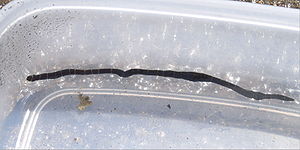Cordworms
| Cordworms | ||||||||||||
|---|---|---|---|---|---|---|---|---|---|---|---|---|

Lineus geniculatus |
||||||||||||
| Systematics | ||||||||||||
|
||||||||||||
| Scientific name | ||||||||||||
| Nemertea | ||||||||||||
| Schultze , 1851 | ||||||||||||
| Orders | ||||||||||||

Cordworms (Nemertea, often also Nemertini) are a taxon of simply built, worm-shaped and often brightly colored animals that are placed next to the primal mouths (protostomia). About 1200 species are currently described. They are mostly marine life. Most species live in shallow waters or near the coast, mostly in the vegetation zone or as endobenthos .
description
The majority of the species are a few millimeters to a few centimeters long and are often brightly colored. However, some species, such as Lineus longissimus , can grow up to 30 meters long. There are even reports of specimens 35 meters long, which would make the cordworms one of the longest animals ever (for comparison: the largest scientifically measured blue whale ever measured 33.58 meters; the tentacles of the Portuguese galley can reach up to 30 meters) .
The characteristic of this group is their special trunk. It lies dorsal to the intestine in a coelom (here rhynchocoel) and can have stilettos and poison glands. If necessary, it is everted frontally and is used for hunting or exploring the area.
Cordworms have extremely strong muscles, which mainly consist of longitudinal and circular muscles. They have a special blood vessel system, which usually consists of two laterally running vessels that are connected at the front and back. There may also be one dorsal and further lateral blood vessels. The excretion of toxic metabolic products takes place via two or more protonephridia , which are mostly located in the esophageal region and the brain region.
The nervous system consists of a cerebral ganglion (brain), longitudinal cords connected by commissures , and a peripheral plexus . The sensory organs are cerebral and frontal organs. In addition, pigment cup oocelles and statocysts can be found, which are used for orientation.
Way of life
Cordworms are carnivorous and feed mainly on small marine invertebrates . When hunting or defending, they use their special proboscis. Most species are part of the epi- and endofauna in littoral and sublittoral marine soils. Only a few specimens are found in freshwater or even terrestrial. The locomotion takes place via the cilia of the ciliated epidermis .
Reproduction and development
There are a few hermaphrodite species, mainly land and freshwater species, but usually there are two sexes that look alike. Only in the species Nectonemertes mirabilis do the males, in contrast to the females, have tentacles on each of their sides. The sexual organs are usually arranged in rows on the sides of the body. The two sexes can spawn this way without touching each other. In some species, however, the male also crawls over the female to pass on his sperm cells. Other species spawn together in mucous sheaths. Depending on the species, fertilization occurs inside or outside the body. There are species that lay their eggs in jelly or chains, and others in which the offspring develop in the mother's body. The shape of the offspring that comes out of the egg is also different. In some species there are already small worms, in others ciliated pilidium larvae or fencer's hat larvae . These larvae swim in the water and feed on very small plants and animals until they molt, then the larva becomes a worm. There are also species that make Desorsche larvae . The asexual worms multiply by means of multiple transverse division. The rear end of the worm divides into 20 or more parts through strong muscle movements. Each of these parts now becomes a worm, with longer pieces dividing every now and then before they develop into an independent living being.
literature
- Wilfried Westheide and Reinhard Rieger (Hrsg.): Special zoology part 1: unicellular and invertebrate animals . 2nd Edition. Elsevier Spektrum Akademischer Verlag, Munich 2007, ISBN 978-3-8274-1575-2 .